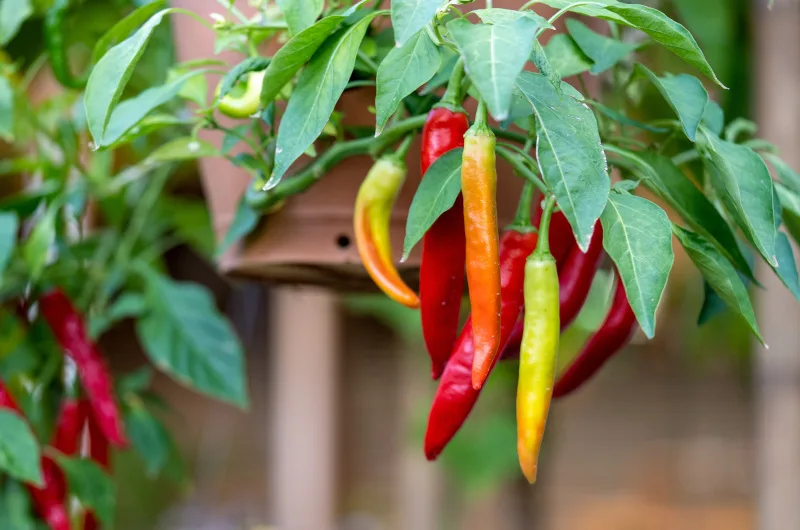How To Grow Chilli Peppers
For many gardening enthusiasts and food lovers, the allure of growing chillis (Capsicum spp.) is hard to resist. The vibrant hues, diverse flavours, and fiery heat levels make chilli pepper an exciting addition to any garden or culinary adventure. In this guide, we will delve into the art of growing chillies, offering valuable insights and growing tips that cater to both beginners and seasoned gardeners.
Understanding Chilli Peppers
Before embarking on your journey to cultivate these fiery gems, it’s essential to understand the basics of growing chillis. Capsicum pubescens, commonly known as rocoto or manzano peppers, is a unique species characterized by its fuzzy leaves and distinctive black seeds. These peppers are known for their heat and are often used to create intensely spicy dishes. However, don’t be mistaken; chilli peppers span a wide spectrum of heat levels, from mild and sweet to scorching hot.
Step-by-Step Guide to Growing Chilli Peppers
Selecting Chilli Pepper Varieties:
The first step in growing chillies is selecting the right variety for your preferences and growing conditions. Capsicum pubescens aside, you’ll find an array of chilli pepper types, including sweet peppers and hot chillies. Popular hot varieties include Habanero, Scotch Bonnet, and Carolina Reaper, each packing its distinctive punch of heat.
Sow Seeds:
To begin the journey, sow chilli seeds indoors during late winter or early spring, about 8-10 weeks before the last frost date in your region. They can be slow growing, so need a long growing season to ensure a reliable crop. Fill seed trays with a well-draining seed compost mix and gently press the seeds into the soil’s surface. Cover the seeds with a thin layer of compost and mist the surface with water to maintain moisture.
Providing Warmth:
Chilli pepper seeds thrive in warm conditions, which aid in germination. Consider using a heated propagator to maintain a consistent temperature of around 75-85°F (24-29°C). This controlled environment encourages quicker and more successful germination. If you don’t have access to a propagator, place the seed tray on a warm windowsill, ideally in a south facing location to maximise the benefit of sun light and warmth.
Transplanting Young Plants:
Once your chilli pepper seedlings have grown their first set of true leaves, they are ready for transplanting into individual pots. Use a high-quality potting mix and ensure each plant has enough space to develop a strong root system. This phase allows the plants to establish themselves before facing the challenges of the outdoor environment.
Choosing the Right Location:
Chilli peppers love heat sunlight, so ideally grow in a greenhouse or polytunnel. If you’re able to do this, choose a sunny spot in your garden that receives at least 6-8 hours of direct sunlight daily. If you’re growing chillies in containers, ensure they can be easily moved to catch the sun’s rays.
Preparing the Soil:
The soil should be well-draining and rich in organic matter. Incorporate compost or well-rotted manure into the soil before planting to provide essential nutrients for your chilli pepper plants.
Planting in the Garden:
When the threat of frost has passed and the soil has warmed up, typically after the last frost date, transplant your young chilli pepper plants into the garden. Space them around 18-24 inches apart to allow for proper air circulation and growth.
Container Cultivation:
If you’re limited on space or prefer container gardening, chilli peppers can thrive in pots. Choose containers that are at least 12-16 inches in diameter and provide adequate drainage holes. Use a high-quality potting mix and ensure the container is placed in a sunny location.
Watering and Feeding:
Keep the soil consistently moist, but not waterlogged. Over-watering can lead to root rot. As your chilli pepper plants grow, they will benefit from regular feeding. Use a balanced, water-soluble fertiliser every two to three weeks during the growing season.
Support and Pruning:
As your chilli pepper plants grow taller and begin to produce fruit, consider providing support with stakes or cages to prevent the branches from bending or breaking under the weight of the peppers. Additionally, pruning can help improve air circulation and encourage larger fruit development.
Managing Pests and Diseases:
Keep an eye out for common pests such as aphids, whiteflies, and spider mites. Regularly inspect the leaves and stems for any signs of infestation. Neem oil or insecticidal soap can help control these pests. Proper spacing and good air circulation can also prevent fungal diseases.
Harvesting:
The moment of truth arrives when your chilli pepper plants start bearing fruit. The harvesting time varies depending on the variety and desired heat level. Generally, chillies can be harvested when they have reached their full size and color. Use clean and sharp scissors to cut the peppers off the plant, leaving a short stem attached.
Growing chilli peppers, whether the blazing hot varieties or the milder sweet peppers, can be a rewarding endeavor for gardeners of all levels. The journey from sowing seeds to harvesting fiery fruit is a fascinating process that involves careful nurturing, attention to detail, and a bit of patience. By following the steps outlined in this comprehensive guide and incorporating the growing tips provided, you’ll be well on your way to becoming a skilled chilli pepper cultivator. Remember, while the path to mastering the art of growing chillies may have its challenges, the bountiful harvest of vibrant peppers and the culinary delights a zing of chilli heat brings to meals makes the effort truly worthwhile.



